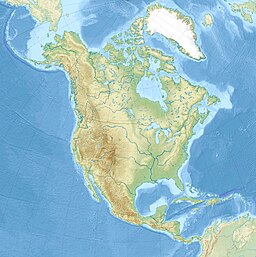The North American Pacific Fjordland, also known as the Great Bear Fjordland,[1] is a marine ecoregion off the western coast of North America, part of the Temperate Northern Pacific marine realm.[2] It contains over 20,000 miles (32,000 km) of coastline extending along the continental shelf from Glacier Bay to Queen Charlotte Sound, and extends 200 miles into the Pacific Ocean. It borders the Gulf of Alaska to the north, the Salish Sea to the southeast, and the Oregon, Washington, Vancouver coast and shelf to the south.
| North American Pacific Fjordland | |
|---|---|
| French: Fjordland du Pacifique Nord-Américain | |
 | |
| Location | Pacific Ocean |
| Coordinates | 54°30′N 131°20′W / 54.500°N 131.333°W |
| Type | Marine ecoregion |
| Part of | Cold Temperate Northeast Pacific |
| Basin countries | Canada and the United States |
The fjordland is connected through oceanographic processes utilizing nutrients and productivity from the North Pacific, and the waterways are critical habitat for substantial Northern Pacific cetacean populations, including fin whales, orca, and humpback whales.[3] Major features include the Inside Passage, a coastal route for ships and boats weaving through a network of passages among the many fjordland islands.
See also
editReferences
edit- ^ Thomson R (1981). "Oceanography of the British Columbia coast". Canadian Special Publication of Fisheries and Aquatic Sciences. 56: 291.
- ^ Spalding MD, Fox HE, Allen GR, Davidson N, Ferdaña ZA, Finlayson MA, Halpern BS, Jorge MA, Lombana AL, Lourie SA, Martin KD (2007). "Marine Ecoregions of the World: A Bioregionalization of Coastal and Shelf Areas". BioScience. 57 (7): 573–583. doi:10.1641/B570707. S2CID 29150840.
- ^ Gregr EJ, Trites AW (2001). "Predictions of critical habitat for five whale species in the waters of coastal British Columbia". Canadian Journal of Fisheries and Aquatic Sciences. 58 (7): 1265–1285. doi:10.1139/f01-078.
